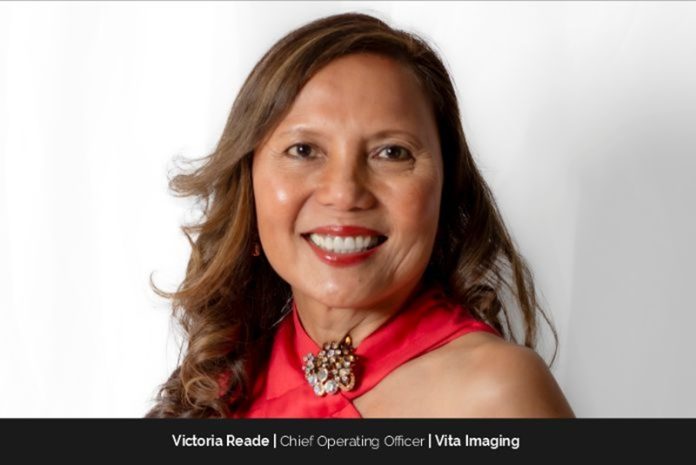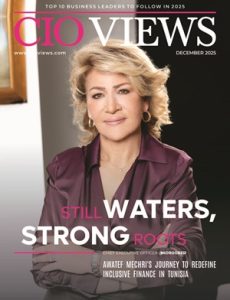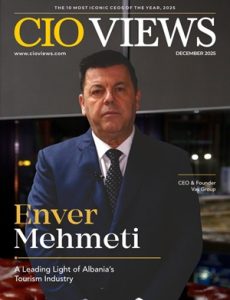Victoria Reade walks into the American Medical Association’s (AMA) CPT Editorial Panel meeting in New York with steely poise. It’s May 2025. She’s there to present the AURA device, as a new and emerging technology, that could change how the world detects skin cancer. No entourage. No hype. Just the culmination of six years of grit, late nights, clinical studies, and regulatory preparation. The stakes are high, but this isn’t her first trial by fire.
Victoria is a global MedTech executive whose work spans diagnostics, medical imaging, oncology, AI/Deep Tech, women’s health, and environmental innovation. At Vita Imaging, she serves as Chief Operating Officer (COO), guiding breakthrough technologies like AURA through the labyrinth of FDA approval, CE Mark, and reimbursement negotiations. If approved, it could expand access to early detection of cancer at the molecular level, worldwide.
But Vita Imaging is only one chapter in her multi-threaded career. A serial entrepreneur since 2004, Victoria divides her time between San Francisco and London, co-founding ventures with international teams like TRS (Dental HealthTech/AI Venture) in the UK, NED (No Expiration Date), a digital social platform for women, and XoVo Women’s Health. She’s also led an environmental health project, a bold initiative linking ocean health and renewable energy to human health, which earned her a 2025 nomination for the Earthshot Prize, one of the world’s top global environmental awards. Victoria is a Fellow of the Royal Society of the Arts (FRSA) joining forces with other global changemakers on healthcare and social policy.
In a rapidly evolving business tech world, surface-level knowledge won’t outpace the change. Victoria is one of those rare leaders who understand both the science and the system, changing both from the inside out. She’s more focused on what happens after she leaves than what happens when she’s in the room. She unites regulators, clinicians, scientific researchers, deep tech innovators, and end users with a clarity that turns ideas into disruptive solutions. Victoria is laying foundations meant to hold long after her footsteps fade, building solutions that carry real weight once the spotlight has moved on.
The Leap from Care to Creation
This global MedTech leader began her career in scrubs, not an executive suit. Her first steps were in busy hospital wings, tending to patients and learning the human side of precision and pressure. But before long, she noticed the ceilings. Some were visible. Others took time to reveal themselves.
“I wanted autonomy,” Victoria says, reflecting on what pushed her from executive leadership into entrepreneurship. “I wanted the opportunity to venture build on a global scale.”
What followed wasn’t a straight line. Healthcare, as she experienced it, had little room for career reinvention. Despite her rising profile in hospital systems, insurance, and physician networks, she found the path to innovation blocked by hierarchy and convention. Business circles weren’t exactly waiting with open arms either. Acceptance had to be earned.
She taught herself by doing. Volunteered for multidisciplinary projects. Learned the machinery of health systems from every angle. And when a few established institutions tapped her to build new ventures from within, she recognized the pattern. This wasn’t just a detour. It was a direction.
“Women make up 70% of the health workforce but remain absent from leadership positions, with only 25% holding senior roles,” she points out, citing a 2024 Think Global Health report. The numbers didn’t surprise her. She had lived the imbalance up close. For Victoria, entrepreneurship was a way to reclaim agency and reshape the system from outside its walls.
She never set out to specialize in just one corner of the industry. Her goal was to grasp the full picture. Now, as a founder and executive in ventures that span healthcare, MedTech, AI, and environmental health, that wide-angle view is no longer a liability. It’s her edge.
Changing the Equation in Skin Cancer Detection
At Vita Imaging, early detection doesn’t depend on access to a specialist. AURA, the company’s flagship device, uses the non-invasive, light scattering technique, Raman spectroscopy, to capture molecular fingerprints that distinguish melanoma, non-melanoma skin cancers (NMSC), and non-malignant skin disorders. It’s user-friendly and intuitive enough for use by GPs, PCPs, PAs, and NPs, widening frontline care.
In a world where dermatologists are scarce and waiting lists long, that accessibility could shift how and where skin cancer is caught.
The potential ripple effects stretch far beyond hospital walls, reaching into patients where early detection can make the greatest difference.
Leadership Lessons from the Frontlines of Healthcare
Honored as one of the “Top 10 Visionary Tech Leaders Shaping the Future in 2025,” Victoria honed her grit in places few would choose to stand. Her clarity of purpose never frayed, even in the furnace of upheaval.
Stepping into hospital administration brought lessons that continue to shape her executive style today. Even to this day, it is rare to see a woman leading a hospital. Taking on that responsibility while grieving the loss of her mother gave her an extremely human perspective, both as a caregiver and as someone dealing with loss.
Communication protocols were revamped to ensure patients and their families received timely, consistent updates across every touchpoint. “I implemented a customer-centric system that prioritized timely and consistent communications between the staff, patients, and their families,” she asserts.
When managing post-merger integration, she saw early on that unifying a fragmented workforce required more than process. It demanded breaking down silos and rallying teams around a common goal. For a diverse team split across day and night shifts, visibility mattered. She made herself available through daily rounds, fortifying trust and cohesion on the floor.
Running a smaller facility in the shadow of larger hospitals taught her to turn perceived limitations into strategic advantages. She positioned its size as a strength, introducing personalized touches like a multi-lingual staff and cultivating its role as a neighborhood community hub.
Victoria also implemented advanced technology into day-to-day operations. By empowering departments with real-time tools to track and coordinate patient care from hospital entry to bed occupancy, Victoria created a culture of accountability, speed, and transparency.
The Long Climb: Women Leaders’ Challenges in Healthcare and Tech
For Victoria, rising through the ranks in healthcare and technology meant facing not one, but two persistent barriers of race and gender. She refers to this intersection as being a “double minority.”
As an Asian woman in executive roles, she found herself operating in industries where leadership often reflected anything but the workforce it claimed to serve. These challenges included overcoming gender and racial bias, both covert and overt, pay disparity, exclusion from decision-making, being underestimated, marginalized, and expected to handle tasks traditionally associated with administrative support.
According to a 2024 Harvard Business Review article by J. Chen and A. Cheng-Cimini, Asians make up around 13 percent of the U.S. professional workforce but hold only 1.5 percent of corporate officer roles in Fortune 500 companies. For Asian women, the numbers are even starker, with less than 1 percent of promotions into the C-suite. Paradoxically, a study of 1,000 U.S. based startups that reached unicorn status (valued at over $1 billion) in the past decade found that one-third had an Asian founder.
To overcome these challenges, Victoria adopted a practical view. “Recognizing that inherent biases existed in the workplace, I did not allow them to limit or define me,” she says. Instead of reacting on impulse, when faced with inappropriate behavior, she approached it as a teaching opportunity and calibrated her response accordingly.
To have a seat at the table, she focused on the work and the mission and strove for constructive outcomes when possible. She was conscious of being a role model for her team, who perhaps had little to no exposure to a female minority leader. Having actively sought and benefited from both male and female mentors, she made it a point to nurture talent in her team. In a field that often speaks about change, Victoria has chosen to live it. She became the voice not only for herself but for many who had long been spoken over, sidelined, or simply unseen. “Over the years,” Victoria shares, “I have felt gratified to receive feedback from staff about how I was viewed as an empowered and inspiring leader.”
The Real Work of Scaling a MedTech Company
Bringing a medical technology company to scale means handling a layered space where innovation alone isn’t enough. Disciplined expansion within a tightly regulated, fast-moving environment is a must. Victoria approaches this challenge with a long-term strategy that weaves together operational efficiency and regulatory compliance with innovation. Clinical and industry partnerships, especially with manufacturers and the supply chain, should be optimized early. Securing both dilutive and non-dilutive funding is essential to build a runway without compromising control. Internally, success hinges on building a collaborative team and establishing quality systems that can withstand scrutiny. Victoria considers that integrating emerging technologies like AI/ML and digital health tools is key to market leadership.
The Breakthrough Moment That Changed Everything
Victoria’s career has been marked by a series of breakthrough moments, each one met with gratitude. But ask her to name the one that redefined her path, she’ll point to the plunge that carried her beyond the bounds of certainty. Leaving behind a secure future in healthcare, she stepped into the unpredictable world of entrepreneurship to launch her own medical device venture. Trailblazing as Founder/CEO wasn’t a single win but the full transition itself, a courageous realignment that tested her determination and ultimately affirmed her vision.
Clinical Insight as Competitive Edge
This sagacious businesswoman has observed that clinicians are often overlooked as valuable assets in favor of engineering and technology. Victoria brings a rare and fresh perspective to the world of MedTech strategy. It is not honed overnight but sharpened by years of clinical expertise and intimate knowledge of the healthcare market. “I believe it’s a ‘superpower’ that enables me to contribute to all aspects of tech development meaningfully,” she says. That clinical grounding influences everything she does, from setting strategy and product development to identifying market opportunities, forging strategic partnerships with Advisors/KOLs (Key Opinion Leaders), spearheading regulatory initiatives, and executing research studies. This comprehensive outlook helps Victoria spot prospects others miss and ensures that innovation stays grounded in patient needs.
Nurturing Collaborative Innovation
To foster innovation and collaboration at Vita Imaging and within her diverse ventures, Victoria embraces a philosophy of multidisciplinary cross-fertilization. Why? It promotes “outside the box” thinking and fuels innovation.
Hence, she creates space for ideas to collide among disparate disciplines, particularly when addressing tricky problems. Victoria often finds herself as the sole clinical expert on teams including scientists, engineers, and technology/IT experts. She approaches this dynamic as a chance to dialogue and learn from each team member, respecting every contribution.
Paying It Forward in STEM
Since 2015, Victoria has mentored rising entrepreneurs through programs like The Hult Prize and California Life Sciences’ FAST Advisory. The exchange is mutual. She contributes expertise drawn from experience and gains inspiration from their creativity and commitment to social change. For women in STEM, this kind of support remains a quiet force behind visible progress.
Work-life Balance as a Practice
Entrepreneurship stimulates her, not drains her. “I have a ‘work hard play hard’ ethos,” Victoria reveals. She treats work as a passion and leans into moments of pause with equal intention. Travel, art, cinema, learning languages, music, creative writing, food, hiking, and time outdoors form the oxygen in her reset. Reconnecting with friends and family sustains her impetus.
Advice for the Next Wave of MedTech Leaders
For those entering the MedTech space, Victoria stresses the importance of gaining work experience in your area of interest. Field-tested understanding offers invaluable insight into the system they hope to change, its customers, and the pain points that could benefit from innovation. “While there is value in academic knowledge,” she advises, “you need first-hand experience to contribute and gain credibility in the industry meaningfully.”
Success, she says, rests on the ability to integrate scientific, clinical, and technical know-how into multi-modal solutions that synthesize disparate concepts. In a complex and highly regulated field like healthcare, it’s essential for these aspirants to clearly identify stakeholders and invest in multiple studies, including user research, pre-clinical, and clinical trials. It will validate their concept and ensure the solution is embraced and utilized by customers.
The Long Road to Approval
The journey to FDA approval for AURA has spanned six demanding years. Victoria led from the front, managing clinical studies, guiding a team with limited regulatory experience, and managing the added pressures of the pandemic. She remained closely involved throughout, ensuring that every requirement was met without compromise. Achieving FDA approval, when it comes, would stand as a shared milestone for her, as a reflection of persistence, teamwork, and her tenacious resolve through one of healthcare’s toughest regulatory paths.
The Drive for a Purpose-Driven Legacy
Victoria’s life is a testament to the belief that a meaningful legacy is built on diverse interests and a passion for making a difference. Her ventures span healthcare, oncology, MedTech, AI/digital health, women-focused social platforms, and environmental initiatives.
“The woman who follows the crowd will usually go no further than the crowd. The woman who walks alone is likely to find herself in places no one has ever been before.” This quote from Albert Einstein is a personal mantra for Victoria. Her greatest hope is to inspire female entrepreneurs to boldly trailblaze, lead purpose-driven lives and create transformative solutions. By sharing her journey, marked by perseverance and the courage to navigate both personal and professional challenges, she hopes to show that success is possible regardless of gender, age, ethnicity, economic status, or education.





